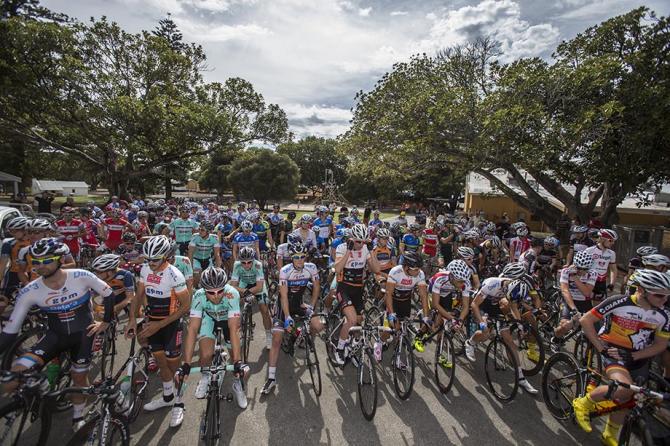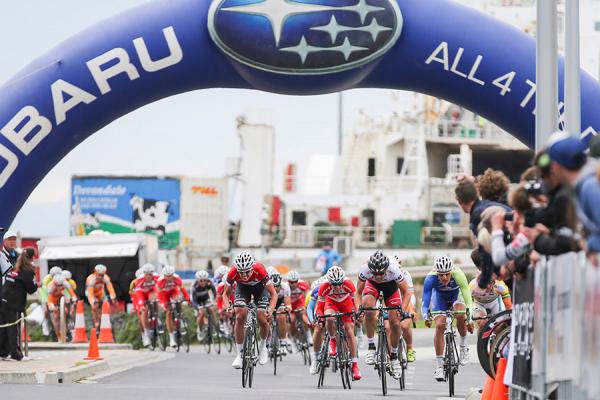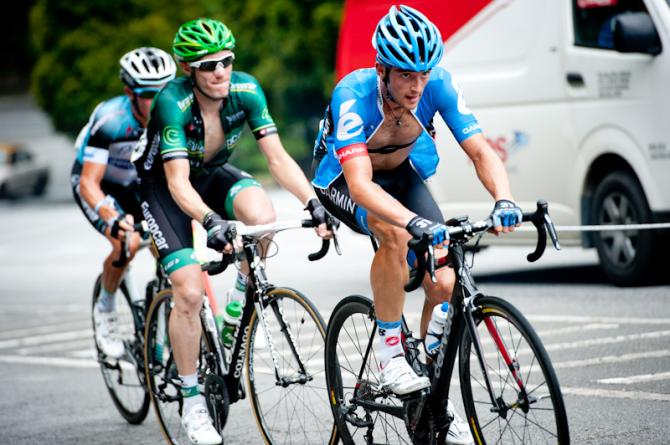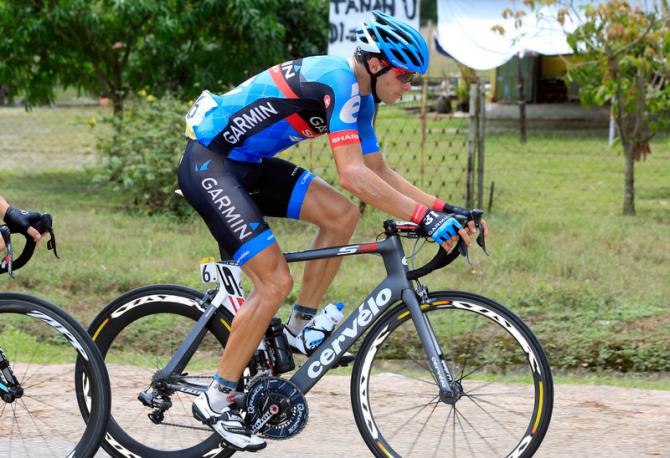Under the microscope: Australian National Road Series Part I
The logistical challenges associated with domestic calendar





The Australian domestic scene is primed to experience one, if not the most comprehensive Subaru National Road Series' that has ever been put together. This season has seen not a significant increase in race days but also registered teams and riders; 32 men's and 15 women's were listed at the start of 2013. With the season having kicked-off for the men at the revamped Woodside Tour de Perth and Huon Salmon-Genesys Wealth Advisers taking an early lead in the series rankings, it seemed appropriate to look at some of the key elements that are vital for the success and continued growth of the local race scene.
Registered teams are significantly up from the past season and there's almost a full year of racing to keep the squads active throughout 2013. However, with growth in popularity comes the expectation of better-run events, greater organisational support, greater safety measures and developments in anti-doping measures - which up till now have been a relatively absent aspect to what is considered to be the top-level of cycling in Australia.
In this first instalment of Cyclingnews' two-part look of the realities of the national domestic calendar, Australian Production Editor and Satalyst - Giant team member Alex Malone looks at the logistical challenges associated with the most-anticipated season to date.
A meeting in Ballarat
In January, during the Cycling Australia Road National Championships the NRS teams were invited to attend a yearly discussion group that would give those essentially funding the race series, that is each registered outfit, a voice into how the upcoming year should be run.
There was plenty to take away from January's discussion which reflected on the previous 12 months and beyond and while there were many positives there is little doubt the NRS has a way to go before it is considered to be a true stepping stone into the professional ranks.
January's meeting saw teams near-demand rolling road closures as a bare minimum for all NRS events with some even suggesting they would not contest an event without such a provision. This is not a threat but a promise, one that places the safety of each rider at the top of the list. Teams are within their rights to demand a basic duty of care for their riders as they are the ones contribute a significant amount to the cost of an event and assist in the continual development of what will ideally be a structured pathway into the professional peloton. If a race cannot be run to a professional standard it should not be run at all. This is a vital element that was taken very seriously by Sean Muir, Cycling Australia's National Manager for the road when packaging up the 2013 NRS calendar.
Get The Leadout Newsletter
The latest race content, interviews, features, reviews and expert buying guides, direct to your inbox!
What were the lessons learned in 2012, what needed improvement and how this could be realistically achieved and implemented almost immediately? These questions formed part of the discussed that took place in January at the Road National Championships and Cyclingnews contacted Muir with the hope of gaining a better understanding of how the outcomes from this meeting could be feasibly implemented into the current season.
"The key point I took away from that meeting was rider safety," Muir told Cyclingnews. "The teams wanted rolling road closures as a bare minimum, or closed roads. All National Series events should be run under that organisation.
"We made a commitment to all of the teams of the National Road Series to ensure a level of safety for all the riders and convoy and we are taking that very seriously. Rider safety should be number-one priority at events."
The North Western Tour, held in New South Wales was a major catalyst that has led to an increased focus around improving the way events handle road closures.
"That [rolling road closures] was the main thing and the Road Commission discussed that at the end of last year after the North Western Tour," said Muir in regard to the only NSW-based tour for 2012 that was ultimately cut short due to rider failing to follow the instructions of the race officials. It was a first-run event that gave the state it's only stage race of the 2012 season - for the men - but difficulties on the road saw the final stage cancelled shortly after it started when riders continually failed to follow the instructions of the race officials. It put a black mark on just the third NRS race of the year and left teams and riders frustrated with the lack of foresight from both the organiser and Cycling Australia - who granted approval to run the race. North Western had been scheduled for inclusion in the 2013 NRS calendar but was added into the 2012 schedule with assistance from Santos - who inked a multi-year with race organisers.
Specific instructions delivered by officials multiple times to the peloton were to stay inside the left-hand lane but with the wind blowing hard onto the bunch's left-side, remaining on the correct side of the road was never going to happen.
The bunch was pulled off the course and a small group raced into the finish with a representative from each team. The overall classification was left unchanged from the day prior but at least a small number of riders got the opportunity to contest the final stage. This at least gave the finishing city of Tamworth what it had planned to see; a bike race.
The tour appeared great on paper; a challenging course, a competitive field and fantastic countryside but it was the basics that were overlooked. The NRS peloton is far from an average club race where pecking order and smaller numbers make it easier to control the movements of the bunch and to assume the bunch will always do as told in this instance is not likely.
Rolling road closures had not been authorised for North Western, due largely in part to the reluctance of NSW police to permit such a format for cycling events. Most other states allow it, for a substantial fee, but up until now the authorities in NSW have not been so willing. That is until this year. Cycling Australia, race organisers, high-profile race organisers like Phill Bates and other people of influence have bound together to provide this basic level of care to riders and the race as a whole.
"North Western was a good tour, it's great for New South Wales and there was a great turnout of teams [in 2012] so it was a disappointing end to the race to have to pull off at the end of the last stage," said Muir.
"It obviously had issues last year in regard to road closures and this year Cycling New South Wales has contacted Phill Bates to promote the event and he has gone up and met with the right people; local police, authorities and councils and they have confirmed rolling road closures for that event too.
"We have worked very closely with the organisers and they have worked closely with the local police units and units in Sydney - which basically say 'yes' or 'no' to rolling road closures. Battle on the Border has confirmed rolling road closures, that has been through a concerted effort by the race organisers and also appointing the chief commissaire very early. That is a key thing we will take out of the early part of the season and implement into later parts of the year."
Providing each individual rider with a standard duty of care during competition should be, and is, paramount to the continued growth of the domestic scene. Despite the dangers of road racing, safety from an organisation perspective is intrinsically overlooked. You only have to turn back the pages to a disastrous 2007 Tour of Canberra where an oncoming car collided with the women's field. The race had been restricted to using the left lane along with the rest of the grades and it was and still is, only a matter of a time before a fatal accident occurs - unless road closures are delivered for every race.
Providing a pathway to Europe
The very nature of road racing, or cycling for that matter is dangerous and there are inherent risks involved in simply lining up at a local club race. The difference with the NRS is that many of the riders competing throughout the year are not simply weekend warriors. They are young, aspiring athletes who ultimately dream of making it to the big league. The WorldTour is the final destination and the Australian scene has demonstrated to be a place where such talent can be fostered and moulded into ProTeam-ready professionals. However, the NRS is not yet a proven gateway into a full-time career. There have been a handful of riders who have made the direct jump but the series is still in a state of relative infancy and it's for this reason that structural developments continue to be a talking point.
Recent departures from Down Under into a top-level teams include Will Clarke (Argos-Shimano), David Tanner (Blanco), Jonathan Cantwell (Saxo-Tinkoff), Nathan Haas, Steele Von Hoff (Garmin Sharp) and more recently Jay McCarthy (Saxo-Tinkoff) but considering the number of teams in the series, there's really a very small percent who will be chosen to make the leap. These particular riders, some more than others, used the domestic calendar to put themselves on the map. Some needed greater exposure in the United States and Europe to finally ink their deal but ultimately they all started at home and the local scene provided them with the stepping stone to move on. Thus, safety and ensuring a minimum standard in how races are run should be of the utmost importance.
It seems like such a simple aspect for any cycling event but the growth in the NRS and the continued increase in quality of riders makes controlling a race much more complex. There could well in excess of 150 riders contesting any one race and with the local peloton getting stronger each year, depth in the field means that organisers can no longer 'ask' riders to stick to one side of the road. There's simply not enough room to house a field of hungry racers who all believe they can win. And that's why Cycling Australia will do everything in its power to ensure that every event on the NRS calendar features closed roads or at the very least, rolling road closures - as does any international race sanctioned by the UCI.
The NRS is not bound by the sport's governing body's regulations in regard to UCI-ranked events - they simply don't exist on the calendar. However, this shouldn't mean that riders are exposed to more dangerous road conditions simply because a race lacks an international ranking.
One particular race that has been a major cause for concern, not only for riders but organisers is the Goulburn to Sydney one-day classic. An early start in the city of Goulburn and 80km of racing on a more-or-less open freeway is a recipe for disaster. Granted, the local police and race officials do a great job of protecting the bunch along the opening section but it will only take a day of severe adverse weather conditions to make the race near impossible to run effectively. The main concern is that the far right-hand lane remains open for traffic with police escorting groups of vehicles past the bunch as it is safe to do so. But, a huge semi-trailer passing a bunch nervously racing above 50km/h is never truly safe and this is one of the events that remain on the 2013 calendar that is still up in the air.
"I don't know how Goulburn to Sydney is going to end up, all I can say is we are working very hard to deliver that promise," said Muir.
"Outside of that there is the Grafton to Inverell which has been run with rolling road closures for the past couple of years and has worked quite well. Goulburn to Sydney is obviously a bit of an issue because it does travel down a major freeway. That was one of the events that were brought up in January and we are looking at the options of the old course which steps away from the highway. That brings up a few other issues; narrower roads and a few other things but we are going through that process at the moment. We are trying to get that rolling road closures across the line," he added.
The anti-doping effort
With a national series that is meant to provide a pathway to bigger and better things, now more than ever seems like the time to step up the anti-doping effort. This is especially pertinent given the current climate surrounding the USADA investigation and the subsequent fallout since its public release.
There is little to suggest that competitors are exploiting the lack of testing at races in order to further their aspiring careers but there is also very few times when a representative from Australia's Sports Anti-Doping Agency, ASADA is present at an event. Most would be able to count the times on one hand when an anti-doping official requested the day's winner, yellow jersey holder and one or two random riders to follow them for testing purposes.
"In the current environment with drugs in our sport being high on the priority list Cycling Australia want to keep at arm's length as much as possible from the testing side of things. We are leaving that up to ASADA. We engage with ASADA to let them know of all the races on the National Road Series calendar. We understand that testing is only done at a very small percentage of road series events last year but we are looking to up that [in 2013]," said Muir.
To be fair, the entire NRS does not run under the same regulations as a UCI-ranked race such as the New Zealand Cycle Classic. That event was forced to postpone the women's stage race this year due to rising costs associated with running a UCI race and the requirement to employ UCI anti-doping officials to run testing at the end of each stage, but this shouldn't mean it is forgone all together.
"We have investigated options of event organisers chipping in to cover those costs or Cycling Australia to cover the costs but at the end of the day it is about $800 for every test. I know it shouldn't come down to money but event budgets must meet targets as well. We are certainly looking at options at the moment where we can increase the amount of testing in the National Road Series. The National Road Series doesn't fall under the same regulations as UCI events but we are looking to increase the number of testing throughout the year. But I just don't have definitive answer on what that means yet," added Muir.
Developments in the NRS series
There were a couple of anomalies that appeared in the list of events scheduled for 2013. One of the most significant was the absence of one of the NRS' few one-day races, the Launceston to New Norfolk. The Goulburn to Sydney, Grafton to Inverell and the Launceston - which acted as a major prelude to the Tour of Tasmania was missing from the calendar released by Cycling Australia late last year. However, course organisers travelled to the southern island-state of Australia recently and Muir expected to make an announcement within the next week or so as to the specifics of the final tour of the season.
To lose such an iconic event, albeit one that has only been in existence for a relatively short period of time, would be disastrous for the series. Multi-day tours are great but it's the one-day races that also allow others to shine.
"That (Launceston to New Norfolk) will be finalised in the next week or so," said Muir. "We will try and get as much course information out and being one of the biggest tours on the calendar, there is obviously a lot of media and team interest."
Anyone who has been a part of the NRS for the past few years would have become extremely familiar and comfortable with making left-hand turns - such has been the criterium-heavy focus on every event on the calendar. The Tour of the Murray is, depending on your preference, the worst or the best of the lot with 10 out of the 14 stages run as criteriums in 2012. This is another area that Cycling Australia is looking at but that won't mean the sprinters will miss out completely.
"Some of the Caribou events were heavily focussed on criterium racing and Cycling Australia has taken the feedback we have got from teams. We will be looking to increase the amount of longer road stages and lessen the amount of times where there are two stages per day. That doesn't mean getting rid of criteriums all together. We will be keeping them in there but will be decreasing the amount in the events that are run by Cycling Australia."
The strength of a number of the top teams in the NRS has arguably led to racing becoming more controlled with each team generally allowed up to eight riders in any one race. This means that a team can quite effectively, given they have the strength, control a race and perhaps leaving the competitive side lacking in spontaneity.
"Rider numbers was also another point and the maximum numbers allowed in each team for each race. The current maximum is eight, while a number of teams and organisers wanted it dropped down to perhaps six. From an organisers point of view they would be able to allow more teams and from a team's perspective it decreases the budget for travelling to and from events.
"The Road Commission discussed that point, like we do every year and we think at the moment eight is a good maximum to have. There are a couple of events, like the Tour of Toowoomba where we have given them a dispensation if you like, to only allow six. That is because the local authorities will allow maximum of 120 riders in a peloton. To allow the huge number of teams we have this year (32), a descent chance to enter the event, we had to lessen the maximum number."
Wednesday's second instalment of the Cyclingnews' NRS feature will look at the financial challenges associated with the most-anticipated season to date.